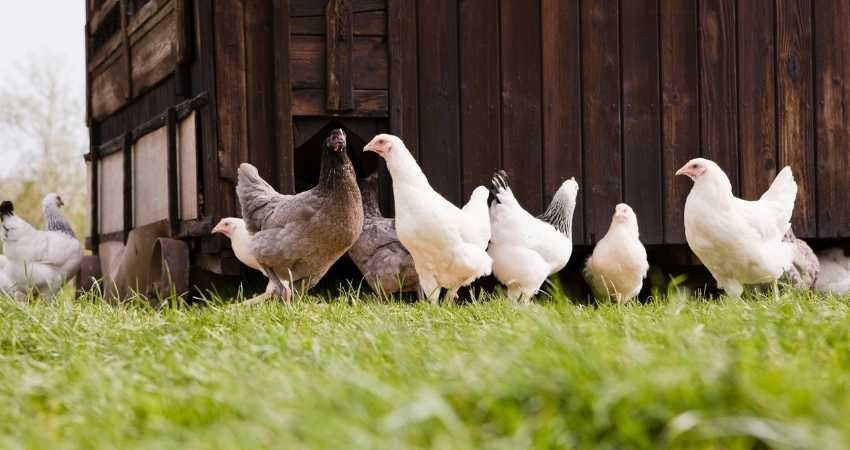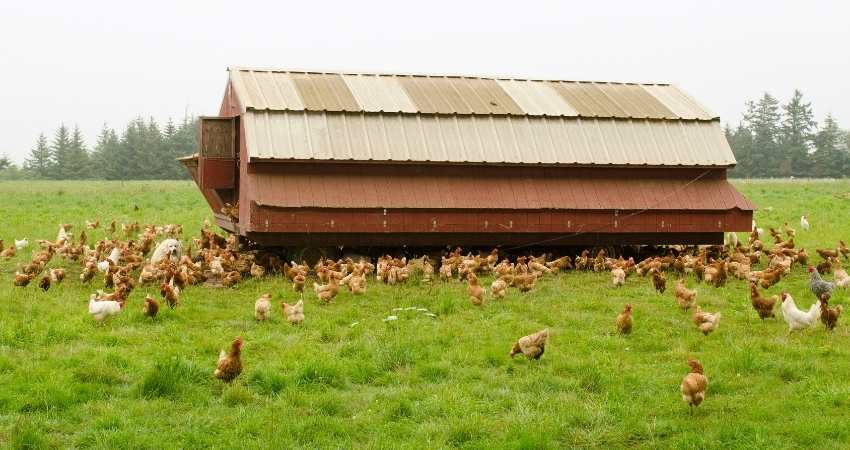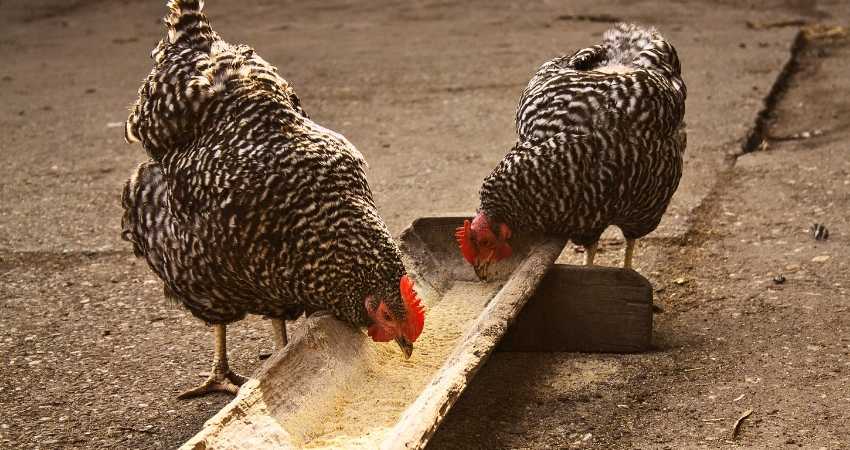Free-Range Chicken vs. Grain-Fed Chicken: Which is Better?
Two common labels found on chicken products is free-range or grain-fed, which one is better?
Free-range chicken is better and can be healthier if raised properly. Since they mostly live outdoors, they can graze on grass or insects on top of their feed. The majority of chickens are grain-fed with assorted grains and either an animal or a vegetarian protein source.
The term grain-fed is typically just a marketing term stating that the chicken eats a grain-based feed, while free-range chickens, in addition to a grain-fed diet, are given access to the outdoors.
Figuring out which is better comes down to what you regard as important when it comes to buying poultry, and if it has a certified humane label that you can find out more about down below.
As a Certified Health Coach I’m often asked about this topic. I also purchase and consume chicken every week. Therefore, I have researched this topic in the past and present. Let’s take a close look at both types of chicken.

What Is Free-Range Chicken?
The USDA classifies free-range chicken as poultry that can go outside versus being kept inside in a chicken coop at all times1.
However, the USDA does not directly check on the poultry’s living standards themselves, and it has led other organizations to step up. This is because having access to outdoors lacks any real regulations and can refer to something as small as the chickens having a small hole they can leave the building from.
With the USDA standards, which are the poultry industry standards lacking any real rules around what free-range truly means, the organization HFAC, Humane Farm Animal Care, has created a Certified Humane label for poultry2.
With the HFAC label placed on free-range chicken, you know you are getting free-range chicken with a living situation that is monitored and ensured to be free-range. With this label, you can guarantee better quality meat than if it is not there and solely labelled free-range.
How about organic? I have a blog post entirely on Organic chicken and Free-range which you can read by clicking here, Is Organic Chicken Free-Range?
Certified Humane Definition of Free-Range
HFAC’s certified humane label defines that to be considered free-range, 2 sq. ft (0.18 sq. m) of space per bird is required. When outdoors, and as weather permits, they must be outside for at least 6 hours per day.
HFAC has also included pasture-raised as a standard under the umbrella term of free-range, which has slightly different standards:
- 1000 birds per 2.5 acres (108 sq. ft or 10 sq. m per bird)
- That chickens must be outdoors year-round (seasonal depending on the climate)
- Have mobile or permanent housing for them to use at leisure
- Maximum of 2 weeks indoors for inclement weather
- Have access to the range by the time they are 4 weeks of age
- Have access to the range for a minimum of 8 hours per day
Other Certified Humane Free-Range Requirements
Other requirements3 for the certified humane label to be placed on a chicken or hen product must meet these following standards of the HFAC:
- Outdoor Area – Must be managed and well-drained to ensure the land around the chicken coop does not become damaged, contaminated, or saturated and soaked with water.
- Exit Areas – Chickens that are kept in the free-range system must be able to exit in multiple areas all around the building where the exit hole is big enough to allow more than one chicken to exit at a time.
- Bathing Area – If the dust bathing4 environment for chickens and hens is located outside, they must have access for a minimum of 4 hours a day in a suitable area.
- Living Vegetation Cover – The area must mainly consist of living vegetation for grazing where the live vegetation such as a grass area is maintained. Land used for cropping is not considered acceptable vegetation.
- Range Area Size – This varies on if it is free-range or pasture-raised. However, in both cases, the range’s perimeter should be within 400 yards (366 m) to the chicken or hen house’s closest door. Land used for cropping is not counted in the range area size.
- Free-Range – 2 sq. ft (0.18 sq. m) per bird
- Pasture-Raised – 1000 birds per 2.5 acres (108 sq. ft or 10 sq. m per bird)
- Parasite Control – If there is a risk of parasites or pathogens to be on free-range land, preventative disease control measures must be in place to protect the health of the chickens.
- Overhead Cover – Chickens must have access to protection so they can escape any potential predators at night.
- Shaded Area – They must also have a sufficient shaded space for hotter months that is big enough for all the chickens, so they are not crowded.

Pros and Cons of Free-Range Chicken
Technically, letting chickens live free-range is better for both the consumer and the chickens well-being. Letting them be outdoors, eat at their leisure, and have access to live vegetation can improve many things for the chickens and further benefit the people who consume them.
However, with the USDA’s limited standards surrounding what it means to raise free-range chickens, the benefits can be limited or obsolete. This is why it is important to look for HFAC’s certified humane label to ensure the best quality.
Pros of Free-Range Chicken
- Free-range chickens tend to be lower in fat. Researchers found that chickens raised in the free-range system versus the conventional method of keeping them indoors resulted in less fat in their breast and thigh areas. Also resulting in lower calories in the thigh meat5.
- According to a 2014 study, they were higher in protein, collagen, zinc, and iron. The free-range group had significantly higher content in all mentioned areas compared to the caged group ((National center for Biotechnology Information: Effect of Free-range Rearing on Meat Composition, Physical Properties and Sensory Evaluation in Taiwan Game Hens)).
- Sensory scores of flavor, chewiness, and acceptability were higher. The thigh and breast meat were scored better in these factors than the caged group and floor-pen group ((National center for Biotechnology Information: Effect of Free-range Rearing on Meat Composition, Physical Properties and Sensory Evaluation in Taiwan Game Hens)).
- The certified humane free-range system is better for the chickens. HFAC developed their free-range requirements to ensure that the free-range system benefits the chickens3. This makes it an environment that puts the chicken’s well-being first, prioritizing their health and stress levels.
- They have better meat quality, gait score, and feather compositions. A study that used 400 chickens found that those raised free-range had improved body conditions, improved physiological characteristics, and a better gut microbial composition, ultimately leading to the chickens improving how they walked, their quality of the meat, and their feathers6.
Cons of Free-Range Chicken
- A study found that the free-range system can reduce growth performance7. With a decrease in abdominal fat and tibia strength that significantly declined, it reduces the size of the chickens raised in this system.
- Lack of industry standards by USDA. With the USDA only clarifying free-range poultry with access to the outdoors, not all free-range chicken will be better in fat, protein, collagen, iron, or zinc levels as poultry farmers are not held to many standards.
- Lack of consistency in chicken. Each farm that produces and distributes free-range chicken will yield different nutritional qualities. The chicken’s well-being will look different on each farm, which means that there can be little to no difference in free-range chicken than conventionally raised if only abiding by industry standards.
- Lack of care for chicken. With the lack of standards, there will be a lack of care for the chickens. They won’t be given a clean, dry, and disease-free area for them to roam around on. They may not have enough space and can become extremely stressed if they are crowded.

What Is Grain-Fed Chicken?
Grain-fed chicken refers to chicken that eats a diet mostly consisting of different grains. These include:
- Wheat
- Oats
- Barely
- Sorghum
- Corn
For a chicken to be considered grain-fed, it means that the majority of its diet consists of grains8. It may also still incorporate other things, along with the grain feed, such as vegetables, animal protein sources, vitamins, and minerals.
Overall, this can refer to two types of grain-fed chicken:
- Vegetarian Grain-Fed – Protein comes from vegetarian sources such as soy, with the remainder of the diet consisting of various grains that are listed above.
- Grain-Fed – Protein comes from animal byproducts. This term states the obvious since almost all chickens in poultry producing nations are fed a diet consisting of grain feed as the majority food source.
Pros and Cons of Grain-Fed Chicken
With grain-fed being a term mostly used as a marketing tactic, it doesn’t separate grain-fed chicken from chickens that are free-range, organic, kosher, or halal. The separation mainly comes from if they are vegetarian grain-fed or not.
Those that are organic or free-range can also be grain-fed chickens. However, those free-range may also eat a diet that consists of grass or insects that are typical for some free-range chickens to graze on during the day but may not be typical for those raised indoors. If that is the case, a higher percentage of their diet would be from grains.
Pros of Grain-Fed Chicken
- A study on the diets of chicken found that whole grain diets increased gizzard size9. An increased gizzard size improves the digestion of grain for chickens, as the gizzard acts as the bird’s teeth and chews the food for it before it passes to the stomach.
- Researchers found that feeding whole wheat can decrease skeletal problems. This then further results in a better ability to grow muscles and grow in size.
- Chickens will receive optimal nutrition that is required for them to thrive. Since the grain feed is manufactured and made specifically for livestock feed, it consists of protein with the proper amino acid levels, energy, vitamins, and minerals to be healthy and grow properly.
Cons of Grain-Fed Chicken
- Marketing tactics used to promote chicken products. The term grain-fed chicken is somewhat misleading as most chickens raised on farms are fed a grain-fed feed. So, having this labeled does not say much about the chicken itself compared to other kinds unless it states what kind of grain it is being fed.
- Lack of natural food sources if they are not also free-range. If the chicken is grain-fed but not free-range, it may not be getting the chance to graze on grass, which may be why free-range chickens are lower in fat.

Which One Should You Choose?
While free-range chicken has become increasingly popular as a healthier choice, you now know that it’s not all that it seems to be. As for the grain-fed chicken, you can assume that all chicken is grain-fed to some extent unless it states otherwise.
If certified by HFAC, free-range chickens are guaranteed to have a diet that consists of grazing on grass. However, if it is not, they aren’t much different from conventionally raised grain-fed chicken.
Depending on what you care about most, here are some questions you can ask yourself when you are trying to decide which chicken to buy,
Do You Care About the Practices Used in How the Chicken Is Raised?
If you are someone who cares about the well-being and living situations of the animals that you eat, then ensuring you buy certified humane free-range or pasture-raised chicken is the right option for you.
This label will be on the front of the product and you can find out where to buy certified humane meat products on their website using the store locator10.
Keep in mind that free-range chicken may also be considered grain-fed, so you may have to look into vegetarian grain-fed poultry if that is something else you care about.
If it is not certified humane by HFAC, then the free-range chicken only abides by the regulation that the chicken must have access to the outdoors, and the extent of its living situation is unknown.
Are You Looking for a Healthier Chicken Option?
A free-range chicken that is properly raised, as per HFAC regulations, is certified humane, would be a healthier option. This chicken is lower in fat and higher in protein, collagen, iron, and zinc. Making the chicken have more of what you do need and less of what you don’t.
If you do not get certified humane regulated poultry, these added health benefits cannot be guaranteed as there is no monitoring or system for checking on how the poultry was raised.
Are You Looking for Better Quality Meat When You Buy Your Chicken?
Free-range chicken is said to produce better quality meat and was found to be better than chicken that was not raised in a free-range system. The free-range chicken was found to taste better, have a better texture in terms of how chewy it was, and was overall more accepted when eaten.
Do You Prefer Chicken That Is Not Fed Animal Products?
If this is your concern, you should look for vegetarian grain-fed options. As long as it states that it is vegetarian grain-fed, it does not matter if it is free-range or not unless you do not approve of chickens eating bugs found outside. This ensures that the chicken was not fed any animal by-products and got its protein source from a vegetarian source such as soy.
Do You Prefer Chicken Breasts or Thighs That Are Larger?
Free-range chickens are likely to produce smaller sizes in chicken as this system can impact their typical growth performance. With less fat and a reduced tibia strength, they are unable to achieve a larger and bulkier size. If this is the case, you are more likely to enjoy conventionally raised grain-fed chicken.
Is There a Real Difference?
Unfortunately, unless the free-range chicken product has a Certified Humane Free Range label approved by the Humane Farm Animal Care organization, free-range chicken can be raised extremely similarly to conventionally raised grain-fed chicken3. As a result, the difference can be slim to none and that is entirely up to the farms they were raised at.
With little monitoring of how often they get to go outside, how much space they have to roam around, and no regulations, if there is access to live vegetation for grazing, there is no clear divide between what free-range means as per USDA standards.
The real difference would only be found if the product has a Certified Humane label, which in that case, health benefits can be present, and the chicken would be living more humanely. This is not to discredit all farmers in the poultry sector. However, without any regulations, not a lot is known.
If you have any questions to ask me about this article don’t hesitate to comment below or email us. You can find an email on our contact page.
Read Next – More Food vs Food
Organic Spinach vs. Regular Spinach: What’s the Difference?
Is Organic Chicken Free Range?
Frozen Salmon vs. Canned Salmon: Which is Healthier?
- USDA: Meat and Poultry Labeling Terms [↩]
- Certified Humane: Our Mission [↩]
- Certified Humane: Human Farm Animal Care: Chickens [↩] [↩] [↩]
- Wikipedia: Dust bathing [↩]
- National center for Biotechnology Information: Effect of Free-range Rearing on Meat Composition, Physical Properties and Sensory Evaluation in Taiwan Game Hens [↩]
- National Center for Biotechnology Information: Free Dietary Choice and Free-Range Rearing Improve the Product Quality, Gait Score, and Microbial Richness of Chickens [↩]
- ScienceDirect: Effect of a free-range raising system on growth performance, carcass yield, and meat quality of slow-growing chicken [↩]
- ScienceDaily: What Does The Label On Your Chicken Really Mean? [↩]
- ScienceDirect: Feeding broiler chickens wheat and barley diets containing whole, ground and pelleted grain [↩]
- Certified Humane: Shop [↩]
